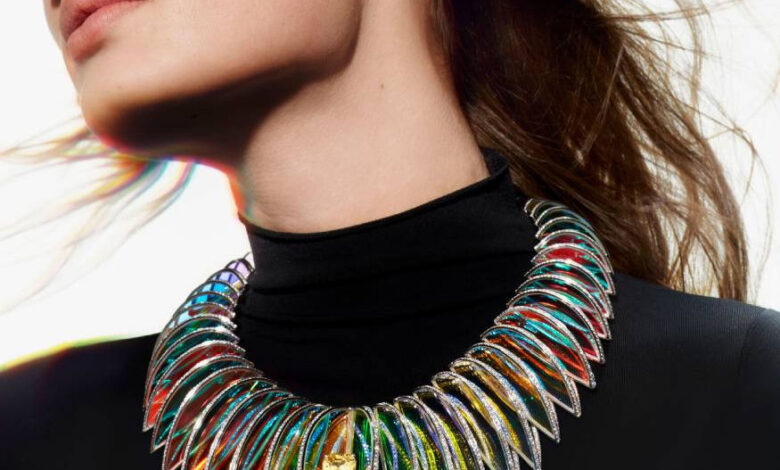Balancing AI Tech With Traditional Craftsmanship

Reputable jewelry designers are using artificial intelligence (AI) and technological innovations into their creations while maintaining traditional methods.
It’s a brave new world for established jewellery houses with the latest techniques and innovations being incorporated into designs once impossible to realise. While other designoriented industries fell in with futuristic applications such as augmented reality (AR) and artificial intelligence (AI) pretty quickly, the initial reticence from the high jewellery world is understandable. After all, the value of a parure lies not just in the precious gems embedded in a stunning piece but also in the brilliant handcrafted savoir faire that each house has come to be known for.
Yet, the sophistication and artistry of any high jewellery piece is itself a showcase of technological ingenuity. Something as innocuous as the making of a clasp, the smoothness of a precious metal, the cutting of a gem, the remarkability of a transformable piece and the structure of a necklace all bear the hallmarks of excellent, even radical, engineering and construction – sometimes by hand, sometimes not.
“Strictly speaking, nobody cuts stones just by hand,” says acclaimed master gem cutter, Victor Tuzlukov in an interview with Prestige Singapore. “All cutters use some device, more or less complicated or precise. Even using a simple stick with glue requires at least a base with a motor and rotating disc, and is considered a simple faceting machine.
“On the other hand, even a machine as precise and multi-functional as Ultratec – more on this later – is not automatic, and used only to fix stones properly and set precise angles for faceting. In this sense, I also cut manually and am just using a more convenient and precise device for it – more precise than, say, just a wooden stick!”
The best maisons are slowly finding a happy medium, quelling the fear that age-old fatto-a-mano techniques would be needlessly replaced by 21st-century technology. Rather, they are choosing to see these innovations as useful tools to help ease mundane tasks as well as aid designers and craftsmen in more important, dynamic undertakings – something they had already been doing with previous technology. Humans are still very much at the helm of the production process even as 21st-century technology is drip-fed into everything from design to sustainability.
By Design
Jewellery design may remain a meticulous process of hand-drawn sketches and physical prototypes but the latest AI-driven 3D printing and CAD (computer-aided design) have emerged as game-changers in the industry.
Where before the programming and accessibility of these programmes posed cumbersome and problematic, the latest software is now more user-friendly, encouraging designers to play with unique shapes and forms, creating innovative designs once considered impossible. They are also better able to streamline the process, realising their concepts faster and more accurately.
Graff, for example, is mindful of using CAD to complement rather than overpower its design process. The design is first hand-drawn or painted with gouache before a high-res scanner records its layout. A prototype is created with both old and new technology including 3D-printed resins and a cast made with a heritage lost-wax method.
Even Italy’s famed golden triangle of Vicenza – whose tradition of goldsmithing dates back to the Middle Ages – Valenza and Arezzo is not immune to the times, experimenting with the latest in powder metallurgy or additive manufacturing that includes grinding precious metals into powder for use in 3D printing.
Boucheron’s Contemplation collection featured a necklace of diamonds suspended in a cloudlike structure, made possible using a mathematical algorithm. Its Holographique line included trailblazing hologram technology from French aeronautics company Saint-Gobain where slices of rock crystal appeared to change colour in chameleonic fashion.
At Fope, the patented technology behind the Flex’it series allows for an extremely modern and versatile way of wearing precious metals, stretching them spring coil-like to fit on a wrist or neck without the need of a clasp. The pieces are composed entirely of 18-carat rose, yellow or white precious metal, making its flexibility all the more impressive.
In The Cut
CAD extends to the new rage for unusual cuts that has seen designers experimenting with unconventional shapes and styles to create statement pieces, heralding an unprecedented time for fantasy cuts in jewellery.
AI-driven perimetric tools that use a special coding system are used by the likes of Tiffany & Co. to allow for the most elaborate and intricate of cuts and designs. More importantly, the technique is allowing precious gemstones to shine brighter than ever before with the kind of unique cuts and facets generated.
The world’s best gem cutters are in a constant quest for perfection and see the latest technology as a means to this end. “Using highly precise faceting machines like Facetron and Ultratec allow me to use faceting diagrams,” says Tuzlukov.
“In fact, it is 3D modelling, represented in three projections with exact coordinates of each facet as instructions for cutting. I use two apps for 3D constructing: GemCad and GemCutStudio.
“Comparing my machine to the commercial ones, mine gives me more creative opportunities because of its high precision and simplicity. It’s impossible to cut artistic designs using commercial faceting equipment, or achieve high-end polishing which can improve the colour of the stone.”
Material World
Really, there has never been a more exciting time for the entire jewellery-making chain. The new technologies afford designers, cutters and setters the chance to work on entirely new materials, some with the kind of otherworldly appeal befitting a Frank Herbert novel.
Some designers have even taken things into their own hands. Cue Niellium, a lacquer-like black amalgam of platinum, palladium and silver, invented by independent jeweller Thomas Hauser. More industrial materials and substances such as carbon nanotubes and space age aerogel (as seen in Boucheron’s Contemplation collection) are being used even as others such as titanium and ceramics are being refined and reengineered.
The growing emphasis on sustainability has also seen jewellery houses increasingly cognisant of their environmental footprint, finding future forward ways of managing it. Responsibly sourced gems are already a given, as are integrating sustainable practices into a jeweller’s ethos with blockchain technology being further refined for greater transparency throughout the supply chain, ensuring every precious piece of jewellery can be traced back to its source.
The latest focus on recycling precious metals has seen even the likes of the Royal Mint introducing pioneering technology from Canadian company Excir into the UK. The innovation, based on a revolutionary chemistry, is able to recover 99 per cent of gold from discarded electronic devices including mobile phones. It is an ideal solution for what is a gargantuan challenge of ethically disposing at least 50 million tonnes of electronic waste (equivalent to 350 Queen Mary 2 cruise liners) produced globally each year. The technology has already enabled The Royal Mint to produce gold with a purity of 999.9. When fully optimised, the process also has the potential to recover palladium, silver and copper.
Digital Attraction
The most obvious and spearheading of new tech drivers lies in digital marketing which is evolving beyond the three dimensional to the digital. At the height of the NFT boom in 2022, for example, Bvlgari launched three high jewellery NFTs, two of which were accompanied by actual necklaces designed by creative director Lucia Sylvestri.
Meanwhile, AR and virtual reality are being used to enhance customer experience. At DeBeers, Cartier and Tiffany & Co, clients are able to virtually try on jewellery so they can visualise how it would look on them before making a purchase.
This is not as transient a service as it sounds. Rather, it has the long-term possibility of freeing the maisons from constraints including security, transport and global availability of the piece when private appointments are made. Digital imaging and 3D modelling are also paving the way for hyper personalisation where clients can now visualise their bespoke designs before they are brought to life.
Future Ready
Innovations will continue to develop and thrive in the jewellery world even while it mitigates this with the humans who drive the industry. What continues to be reverently upheld is the end goal, that is, to enhance the brilliance and value of the jewellery it creates, whether it employs cutting-edge technology… or not at all.
“Sometimes – especially when working with very expensive material – I don’t use diagrams at all. Instead, I follow the shape of the rough stone during cutting to maximise weight and, accordingly, value of the stone,” Tuzlukov affirms. “Sometimes when I get a stone for re-cutting, I just catch each facet and re-polish them without any other correction.
“It takes minimal losses yet the colour improves so much that the value of stone could increase up to 20 per cent! It sounds ridiculous, but it’s true.”
(Main Image: Boucheron)
This article was first published in Prestige Singapore



